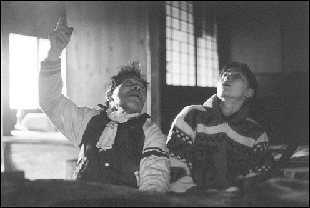|
|
|
監督・編集:河瀬直美
Director, Editing : Kawase Naomi |
1969年、奈良市生まれ。1989年、大阪写真専門学校(現ビジュアルアーツ専門学校)映画科卒業。1990年より4年間、同校講師として勤務。1993年、幼い頃に生き別れになった父親を探す過程を映画にした『につつまれて』がイメージフォーラムフェスティバルで奨励賞を受賞。同年、奈良を舞台にした劇映画『白い月』がぴあフィルムフェスティバルの招待作品となる。1995年には、山形国際ドキュメンタリー映画祭において、育ての親であるおばあちゃんとの関係を綴った『かたつもり』が奨励賞を、『につつまれて』が国際批評家連盟特別賞を受賞。この間、国内外の映画祭において作品が招待上映される一方、1993年秋に<組画>を結成、1995年には有限会社組画を設立。1996年3月、横浜美術館主催による、国内の映像作品の作品選定を務めた映画上映会「煌ら」を開催、5月には同美術館にて、一般参加による16mm映画製作ワークショップ「光をつかめ!」を手掛ける。同年夏、初の35mm劇映画『萌の朱雀』(製作:日本衛星放送、バンダイビジュアル)を脚本・監督。1997年、新作『杣人物語』を完成させる一方で『萌の朱雀』がロッテルダム国際映画祭で国際批評家連盟賞、シンガポール国際映画祭で主演女優賞、カンヌ映画祭でカメラドールを受賞。 Born in 1969 in Nara. After graduating from the Osaka School of Photography (currently the School of Visual Arts) in 1989, worked as a lecturer at the school for four years. In 1993, Embracing, which put on film her search for the father who abandoned her in her youth, won the Encouragement Award at the Image Forum Festival and White Moon, her fiction film set in Nara, was invited to show at the Pia Film Festival. At the Yamagata International Film Festival '95, Embracing was given a Special Mention FIPRESCI Prize and Katatsumori, her portrait of the grandmother who raised her, won an Award for Excellence in the New Asian Currents program. As her films began showing at festivals in Japan and abroad, she formed Kumie in 1993 and Kumie, Ltd., in 1995. At the Yokohama Museum of Art in 1996, organized and selected films for " Kirara, " a program of domestic films held in March, and in May managed the 16mm production " Grab the Light " that was open to general participation. That summer directed and wrote the screenplay for her first 35mm fiction film Suzaku, which in 1997 won the FIPRESCI Prize at the Rotterdam Film Festival, the Best Actress Award at the Singapore Film Festival, and the Camera D'Or at the Cannes Film Festival. Completed her new film, The Weald, in 1997. |
 |
|
|
『杣人物語』は、奈良県吉野の、山に生きる6組の老人たちを描いた作品である。 まず、河瀬直美は彼らの心に飛び込み、彼らの肉声を虚心に聞こうとする。彼らの暮らしの分析を廃し、ありのままの彼らを見つめ、体感しようとしている。 作品にときおり挿入される哀調を帯びた唄に導かれて、老境をむかえるひとり暮らしの婦人の独白や、子供を亡くした夫婦の悲しみや、村人の夢がつぐみ出されてくる。人が去り、かつての賑わいを取り戻せないままに、つつましい日々を送る村人の暮らしぶり。 しかし、哀しみに彩られながらも、彼らの表情やしぐさが、いさぎよく明るいのは、河瀬のフィールドワークと、しなやかなキャラクターに負うところが大きいと思う。さらに、変幻自在なカメラワークは、陽光の中の村人をとらえたかと思うと、土間を吹き抜ける透明な風や、漆黒の森をうつし出し、村の風土と時間を視覚化する。 ふと、思う。日本の原郷とは、このようなものであったことだろうと。 |
The Weald is a portrayal of six groups of elderly people living
in the mountains of Yoshino, Nara Prefecture. Kawase Naomi goes
straight to their hearts, keenly listening to their stories. Refusing
to analyze their lives, she describes these people just as they
are. Led along by inserts of a mournful melody, the film weaves
together the solitude of a single woman nearing old age, the sadness
of a couple who have lost a child, and the dreams of the villagers.
People leave, and the villagers continue to live their modest
lives unable to regain their past energy. Kawase's remarkable
fieldwork and flexible personality allow the optimistic expressions
and brave gestures of these people to shine through their melancholic
lives. Just when you think her versatile camerawork has captured
the villagers in sunlight, pictures of the transparent wind blowing
over a dirt floor and a forest of lacquer-like trees visualize
the time and climate of the village. It suddenly comes to mind
that this is what the Japanese homeland was like. - Fuseya Hiroo |
|
|
|
|
監督のことば “杣”―そま―。言葉の響きが懐かしかった。どんな字を書くのですか?という問いに、キヘンに山と書くんやと教えられて、書いてみた。意味は?山で暮らす人の事を全般に昔から“杣”と呼んどる。なるほど。初めて聞いた言葉、初めて書く字に瞬間で惚れ込んでしまった。キヘンをニンベンに変えると“仙”になる。“仙人”って人生を超越している人の事やん。そう言えば昔、どうやったら“仙人”になれるかと問い詰めて親を困らせた事がある。 “杣人”―そまうど―。奈良県西吉野村平雄に住む彼らから、人生を豊かにするヒントをたくさん戴いた。彼らの生きてきた日々の積み重ねが、この地に根づき、自然に還る。大木が雨風にも暑冷にも堪え、ただそこに在る様に人生の遍歴に堪え、彼らのシワは深く刻まれてゆく。彼らの紡いだ人生の「事実」を自分なりの「真実」に置き換えて私は映画で紡ぎ出す。「まえ」から「いま」、「いま」から「さき」へ続く映画でありますように。 |
Director's Statement The Japanese title for The Weald is " Somaudo monogatari, " a phrase that includes the unusual ideograph " soma. " It, like the word " weald, " has a nostalgic, old-fashioned ring to it. When I asked an acquaintance how to write it, I was told it combined the character for " tree " with that for " mountain. " I tried writing it myself and asked what it meant. The reply was that things relating to people who live in the mountains have generally been referred to as " soma " for ages. That made sense. The minute I first heard and wrote this word, I fell in love with it. If you change the " tree ? part of the ideograph to the character ? people, ? it becomes ? sen ? or ? hermit. ? Hermits are people who've been able to transcend everyday existence, aren't they? Now that I think about it, a long time ago I once made my mother mad pleading with her to teach me how to become a hermit. ? Somaudo ? adds the ideograph for ? people ? to ? soma. ? I was given a lot of hints on how to enrich life from the soma people who live in Hirao, Nishiyoshino-mura, Nara Prefecture. The accumulation of their lived days has taken root in the earth and returned to nature. Just as massive trees withstand the wind and the rain, the cold and the heat, these people endure the twists and turns of life by simply existing, developing deep wrinkles. Replacing the ? facts ? of the life they have spun with my own ? truth, ? I spin a tale in cinema, so that this may become a film that continues from the past to the present, the present to the future. |
